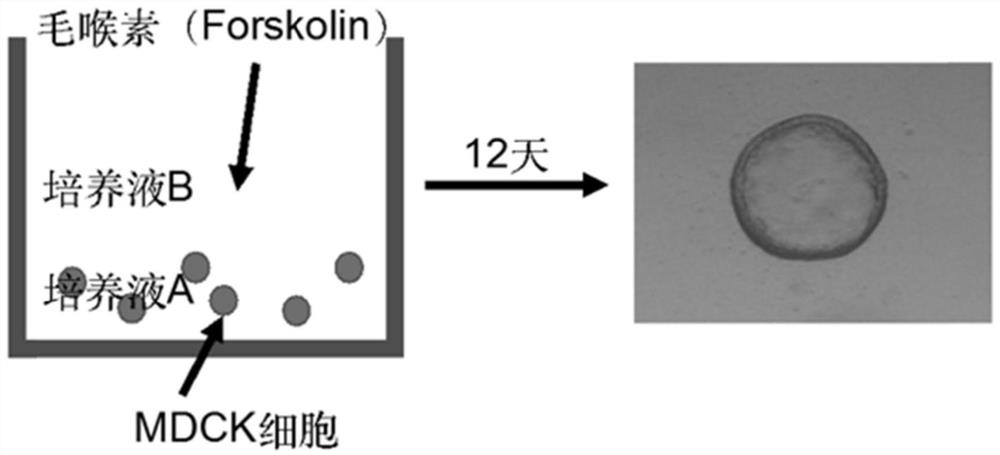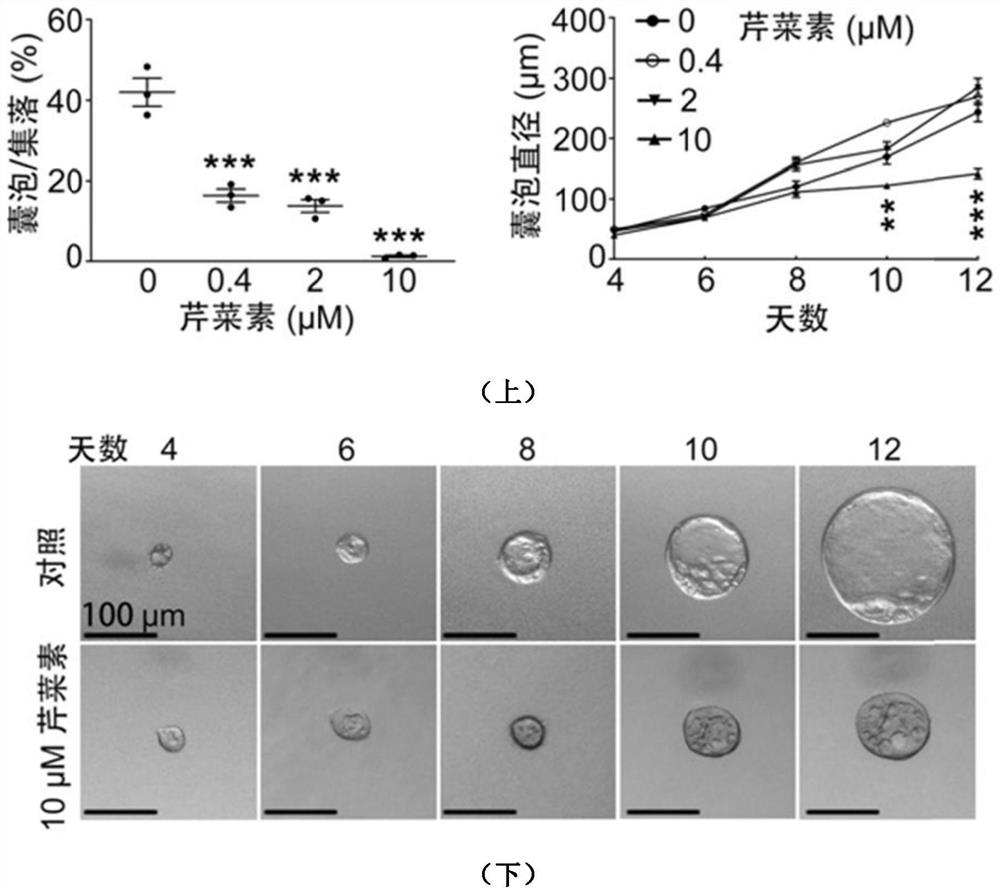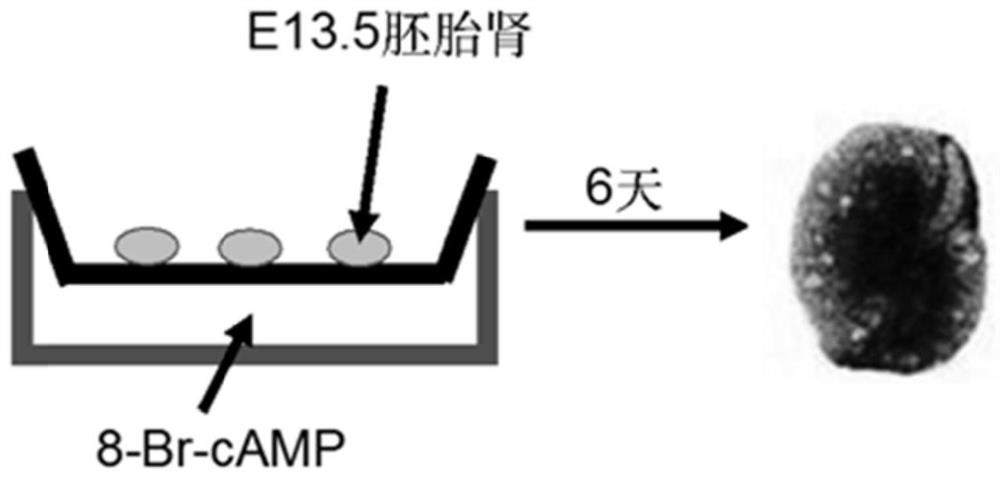Application of apigenin in preparation of medicine for treating and/or preventing autosomal dominant hereditary polycystic kidney disease
A technology for autosomal and polycystic kidney disease, applied in drug combinations, pharmaceutical formulations, urinary system diseases, etc., can solve problems such as limiting clinical applications
- Summary
- Abstract
- Description
- Claims
- Application Information
AI Technical Summary
Problems solved by technology
Method used
Image
Examples
Embodiment 1
[0032] Embodiment 1 apigenin is to the inhibition of vesicle growth
[0033] MDCK cells were cultured in three-dimensional Matrigel (Purecol Collagen, Inamed Biomaterials Fremont Company, Cat. No. 5409) in vitro. Such as figure 1 , Culture solution A is a mixture of three-dimensional matrigel added to 10xMEM culture solution, wherein the concentration of three-dimensional matrigel is 2.9mg / ml, the concentration of HEPES (4-hydroxyethylpiperazineethanesulfonic acid) is 10mM, and the concentration of penicillin is 100U / ml , The concentration of streptomycin is 100 μg / ml, and the pH is 7.4. Culture medium B is DMEM / F12 medium containing FBS and forskolin (FSK, Sigma Company, product number F6886). The concentration of FBS is 10%, and the concentration of forskolin is 10 μM. DMEM / F12 culture medium is a liquid obtained by mixing equal volumes of DMEM medium (Invitrogen, USA, catalog number 12100-046) and F12 medium (Invitrogen, USA, catalog number 21700-075).
[0034]MDCK cell...
Embodiment 2
[0038] The inhibition of embodiment 2 apigenin to mouse embryo kidney vesicle growth
[0039] C57BL / 6 mice over 6 weeks old (Experimental Animal Center, Peking University Health Science Center) were mated with males and females in the same cage at a ratio of 1:1, and observed whether the female mice had vaginal plugs in the morning of the second day. The mouse has been pregnant for 0.5 days; if there is no vaginal plug, separate the cage first, close the cage again at night, and observe again the next day. The pregnant female mice were fed separately for 13 days, and the embryonic kidneys were taken on the 13th day and placed in the upper chamber of a transwell plate (Corning Company, Cat. No. 3401) for culture. Add DMEM culture medium containing 8-Br-cAMP (Sigma Company, product number B-5386) with a final concentration of 100 μM to the culture wells of the lower layer for culture. Under the action of 8-Br-cAMP, multiple progressive The grown vesicles can be used as an in vi...
Embodiment 3
[0043] Embodiment 3 in vivo experiments
[0044] The mice used were obtained as follows: the Pkd1 flox / flox Mating of mice and Ksp-Cre mice to obtain a generation of Pkd1 + / -; Ksp-Cre mice, Pkd1 + / - ; Male mice and female mice of Ksp-Cre mice were mated to obtain wild-type mice Pkd1 + / + ; Ksp-Cre and Pkd1 flox / flox ; Ksp-Cre mice (kPKD mice). Among them, Pkd1 flox / flox The genetic background of mice and Ksp-Cre mice are C57BL / 6 mice, see literature (Wang W, Li F, Sun Y, et al. Aquaporin-1 retards renal cyst development in polycystic kidney disease by inhibition of Wntsignaling. FASEB J .2015;29(4):1551-1563.). Pkd1 flox / flox The mouse is a mouse with whole kidney-specific knockout of Pkd1 gene under the background of C57BL / 6 mouse, which develops rapidly progressive ADPKD after birth, and kidney vesicles can be observed on the first day after birth, which can be Survive for about 10 days. Gene identification was performed on the first day after the birth of the mouse...
PUM
 Login to View More
Login to View More Abstract
Description
Claims
Application Information
 Login to View More
Login to View More - R&D
- Intellectual Property
- Life Sciences
- Materials
- Tech Scout
- Unparalleled Data Quality
- Higher Quality Content
- 60% Fewer Hallucinations
Browse by: Latest US Patents, China's latest patents, Technical Efficacy Thesaurus, Application Domain, Technology Topic, Popular Technical Reports.
© 2025 PatSnap. All rights reserved.Legal|Privacy policy|Modern Slavery Act Transparency Statement|Sitemap|About US| Contact US: help@patsnap.com



